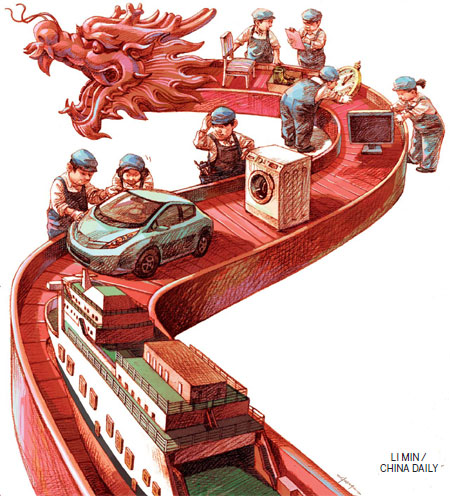High-end manufacturing holds the key
Updated: 2013-03-01 08:47
By Zheng Yangpeng (China Daily)
|
||||||||

Two major developments that took place earlier this year are expected to have far-reaching implications for the global manufacturing sector, and particularly in China. At first glance, they appear to be rather innocuous economic predictions. But a closer look reveals that while the global manufacturing industry is tottering, China is still proving to be the lifeline for many global companies.
The 2013 Global Manufacturing Competitiveness Index prepared by global professional service firm Deloitte Touche Tohmatsu Ltd and the US Council on Competitiveness, released in January, indicates that China is not only the most competitive manufacturing nation in the world presently, but will continue to retain that ranking for the next five years.
|
||||
Ma Jiantang, the National Bureau of Statistics chief, had earlier in January indicated that though China's labor force had declined by 3.45 million last year to 937 million, it still continued to be the nation's "biggest resource advantage".
Other risk factors for China include rising labor and land costs, the increasing competitiveness of other emerging markets, and a trend of relocating industries from developing countries to developed ones.
However, the decline in China's working-age population is something that most economists would not have anticipated as it comes three years ahead of the previous predictions made by the World Bank. The country's demographic dividend - when the largest section of society is of working age and the dependency ratio is low - has contributed to more than 30 percent of its rapid economic growth, an earlier World Bank report said.
In real terms, what the decline in working-age population means is that the endless supply of cheap labor from China, which accounts for more than 11 percent of the world's exports, is no longer a reality, but a memory.
Wu Yu, a manager at a Suzhou-based factory, is one of several Chinese businessmen who have been affected by recent developments. Labor shortage and rising labor costs are the main challenges for Wu's company, a unit of the Taiwan-based computer maker Pegatron Corporation.
Wu says that most of his employees are those born after 1990 and work for average seven months before they seek fresh prospects with other companies.
"These youngsters are more ambitious and have bigger dreams than their parents. They want to explore the world and leave the job when they find it boring," he says.
"Like every other Chinese, they also want to own a house. But in Suzhou, that dream is almost impossible to realize. When they realize this, they are disappointed and often leave for a higher-paying job in other cities."

 Li Na on Time cover, makes influential 100 list
Li Na on Time cover, makes influential 100 list
 FBI releases photos of 2 Boston bombings suspects
FBI releases photos of 2 Boston bombings suspects
 World's wackiest hairstyles
World's wackiest hairstyles
 Sandstorms strike Northwest China
Sandstorms strike Northwest China
 Never-seen photos of Madonna on display
Never-seen photos of Madonna on display
 H7N9 outbreak linked to waterfowl migration
H7N9 outbreak linked to waterfowl migration
 Dozens feared dead in Texas plant blast
Dozens feared dead in Texas plant blast
 Venezuelan court rules out manual votes counting
Venezuelan court rules out manual votes counting
Most Viewed
Editor's Picks

|

|

|

|

|

|
Today's Top News
Boston bombing suspect reported cornered on boat
7.0-magnitude quake hits Sichuan
Cross-talk artist helps to spread the word
'Green' awareness levels drop in Beijing
Palace Museum spruces up
First couple on Time's list of most influential
H7N9 flu transmission studied
Trading channels 'need to broaden'
US Weekly

|

|











